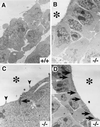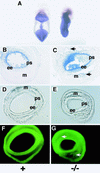The mouse snail gene encodes a key regulator of the epithelial-mesenchymal transition
- PMID: 11689706
- PMCID: PMC99982
- DOI: 10.1128/MCB.21.23.8184-8188.2001
The mouse snail gene encodes a key regulator of the epithelial-mesenchymal transition
Abstract
Snail family genes encode DNA binding zinc finger proteins that act as transcriptional repressors. Mouse embryos deficient for the Snail (Sna) gene exhibit defects in the formation of the mesoderm germ layer. In Sna(-/-) mutant embryos, a mesoderm layer forms and mesodermal marker genes are induced but the mutant mesoderm is morphologically abnormal. Lacunae form within the mesoderm layer of the mutant embryos, and cells lining these lacunae retain epithelial characteristics. These cells resemble a columnar epithelium and have apical-basal polarity, with microvilli along the apical surface and intercellular electron-dense adhesive junctions that resemble adherens junctions. E-cadherin expression is retained in the mesoderm of the Sna(-/-) embryos. These defects are strikingly similar to the gastrulation defects observed in snail-deficient Drosophila embryos, suggesting that the mechanism of repression of E-cadherin transcription by Snail family proteins may have been present in the metazoan ancestor of the arthropod and mammalian lineages.
Figures





References
-
- Alberga A, Boulay J-L, Kempe E, Dennefeld C, Haenlin M. The snail gene required for mesoderm formation in Drosophila is expressed dynamically in derivatives of all three germ layers. Development. 1991;111:983–992. - PubMed
-
- Barnes J D, Crosby J L, Jones C M, Wright C V E, Hogan B L M. Embryonic expression of Lim-1, the mouse homolog of Xlim-1, suggests a role in lateral mesoderm differentiation and neurogenesis. Dev Biol. 1994;161:168–178. - PubMed
-
- Batlle E, Sancho E, Franci C, Dominguez D, Monfar M, Baulida J, Garcia de Herreros A. The transcription factor Snail is a repressor of E-cadherin gene expression in epithelial tumour cells. Nat Cell Biol. 2000;2:84–89. - PubMed
-
- Belo J A, Bouwmeester T, Leyns L, Kertesz N, Gallo M, Follettie M, De Robertis E M. Cerberus-like is a secreted factor with neutralizing activity expressed in the anterior primitive endoderm of the mouse gastrula. Mech Dev. 1997;68:45–57. - PubMed
-
- Boulay J L, Dennefeld C, Alberga A. The Drosophila developmental gene snail encodes a protein with nucleic acid binding fingers. Nature. 1987;330:395–398. - PubMed
Publication types
MeSH terms
Substances
Grants and funding
LinkOut - more resources
Full Text Sources
Other Literature Sources
Molecular Biology Databases
Research Materials
